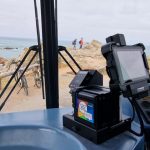One of England’s great counties, Northumberland is sometimes treated as little more than a stop-off along the A1 between England and Scotland. In the first of a two-part feature, Stuart Render turns off the A1 and discovers why the county deserves a closer inspection
Mention the name Lancelot Brown in relation to coach touring and you may be struggling to make the link. However, add in his nickname ‘Capability’ and you’ll immediately recognise the renowned 18th century landscape architect (1716-1783).
He became known as 'Capability' because of his fondness of describing a country estate as having a great 'capability' for improvement? It seems he rejected the formal ‘French’ style of gardening and concentrated on echoing the natural undulations of the English landscape, changing the face of the country, designing country estates and mansions, and making flowing lakes and serpentine rivers.
Depending on whose history you read, Capability Brown is reported to have had a hand in designing (or advising on) anything from 200 to 300 gardens.
Next year sees the tercentenary of his birth and a programme of events and activities is being planned.
Kirkharle Courtyard
Which brings us rather nicely to Kirkharle Courtyard, a unique visitor centre located just off the A696, between Newcastle and Otterburn, and just seven miles from its more famous neighbour, Belsay Hall.
Capability Brown was born in Kirkharle, and baptised at the local church where a plaque records the event. After leaving school he began work as a gardener on the Kirkharle estate, leaving in 1739.
Kirkharle Courtyard houses 12 craft workshops and a 60-seat coffee house serving home-cooked food. Branded as ‘Capability Brown’s Kirkharle Coffee House’, the owners are making sure the connection isn’t missed.
Visitors can watch craftsmen and women at work, explore the different craft shops, take a stroll around the Capability Brown-inspired lake on a one kilometre level path, or visit the ancient church.
Owner of Kirkharle Courtyard is Kitty Anderson.
“We can offer interested groups a short presentation on the history of the centre and Capability Brown’s life in the village,” she says. “In 2016 we’ll be playing an important role in the anniversary celebrations, so it will be a good time to bring groups that have an interest in gardens, or just want to be part of something special.”
Kitty only accepts one coach group at a time, so pre-booking is essential. It’s quite a tight entrance into the site, and coaches drop off right in the middle.
“We recommend a good hour for a visit, longer if you want to have refreshments or lunch,” she says. “Don’t think you can do justice to a visit with a 30-minute stop. It simply isn’t long enough!”
This is a delightful stop, with a mix of mostly hand produced items that are made by the people you actually get to meet, or by other local artists. A Channel 4 documentary with Alan Titchmarsh, featuring Kirkharle, is due to be broadcast in the Autumn.
Unusual Wallington
Over the years there’s been an opportunity to visit a range of National Trust properties, from the always excellent Mottisfont in Hampshire, to the less than impressive…, well, it would be churlish to say. Sometimes, while the property itself may be world class, it can be the people on the door, volunteers they may be, who let the side down.
Just a couple of miles from Kirkharle is Wallington, a National Trust property that can firmly take up its position in the rankings alongside Mottisfont. A welcoming staff, a house full of surprises, and what surely must be one of the best walled gardens in the land – what more could you ask for?
Completed in 1668, the house was the home of Sir Charles Philips Trevelyan, Socialist MP and described as an ‘illogical Englishman’. He died in 1958 and the estate was gifted to the National Trust. It opened to the public in 1968, yet for many people, it’s an undiscovered gem.
A visit to the house gives you the opportunity to discover more about Sir Charles and his unconventional family. You can explore the history of Northumberland in huge and really rather remarkable pre-Raphaelite paintings around the Central Hall, or take time to discover the beautiful furniture, treasured collections, including ceramics, and quirky curiosities in each room. On one landing, steps lead you into what can only be called a museum of ‘odd’ and exotic items. There’s even a display of dolls houses.
There’s free flow around the house, a cafe for groups, and, should it be required, a tiny little tea room hidden away that will surely tempt more than one member of your group.
The house sits in a 13,000 acre estate. Allow plenty of time for a visit because it’s the walk through part of the grounds and on to the walled garden that’s surely a must-see.
The Trevelyans liked fun, and the garden is certainly fun. It sits on a slope, with many different levels. It was beloved by Lady Mary Trevelyan and remains a beautiful haven whatever the season. The website sums up a visit – “Enter through Neptune's Gate, sweep down the stone staircase, by the Mary Pool and soak up the tranquil atmosphere. Wander past colourful borders and enjoy the scent of the flowers in the Edwardian conservatory.”
Talking to one of the rangers, it seems that many local people return week after week, such is the appeal. Large parts of the main grounds are being restored to how they would have looked in Wallington’s heyday.
The admission price, for groups of 15 or more, is £9.70. Coach drivers and the group organiser get free admission, and the driver receives a voucher to use in the Clock Tower Cafe.
Sometimes, country houses can leave you cold. Sometimes, it can be hard to remember which country house you’re seen, such are the similarities. Not so for Wallington. This is a real gem, and well worth a visit.
Tea on the tracks
An itinerary taking in Wallington and Kirkharle may well include a visit to nearby Kielder Water & Forest Park. Access for coaches is usually via the A696 and turning off in Otterburn.
On the way to or from Kielder you pass through the village of Bellingham (pronounced, unusually, as Bell-ing-jum). A short way along the Woodburn Road and you come to the site of Bellingham station, the location for two fully restored 1957 Mark 1 railway carriages.
This is Carriages Tea Room, offering a unique stop-off for a light lunch of afternoon tea.
The carriages were delivered in 2011 – a YouTube video tells the story – and opened in 2012 after a major refurbishment. The front carriage is the dining area, complete with its original train-style booth seating and tables. The second carriage forms part of the Bellingham Heritage Centre, which sits alongside the carriages.
The Tea Room is owned and managed by mother and daughter Christine and Sarah Billany.
“All the food we serve is prepared on the train,” says Christine. “We use real vintage china and tiered cake stands. There’s a dedicated coach parking space close to the carriages. Pre-book and we can have everything ready for when you arrive, including freshly baked scones and our homemade cakes.”
Bellingham Heritage Centre tells the history of the village and the valley. Of particular interest is a small exhibition telling the story of the Border Reivers. From the 13th century through to the beginning of the 17th, the border lands between England and Scotland were home to the Reivers, the word ‘Reive’ being an early English word meaning ‘to rob’. These lawless gangs, from both English and Scottish families, survived by plundering livestock as well as being engaged in kidnapping and racketeering. The Heritage Centre also features a collection of railway memorabilia, a photographer’s shop, and many fascinating items.
There’s a small entrance fee of £2.50 with 50p off for groups of 10 or more. Talk to Christine at the Carriages Tea Room and she can make all the arrangements.
Taking to the water
It’s a 10-mile journey from Bellingham to the start of the expansive Kielder Water & Forest Park.
At the heart of the park, which cover 250 square miles in total, is Kielder Water, the biggest man-made lake in northern Europe, and the largest reservoir in the UK by capacity (Rutland Water is the largest by surface area).
Specialist groups will head for the park to enjoy the walking and outdoor activities. For a touring itinerary, a visit is likely to start at Tower Knowe Visitor Centre (Knowe pronounced ‘now’) where there’s an exhibition telling the story of how the valley was flooded in 1982 to satisfy an expected, but unrealised, demand for water to support the UK’s booming industrial economy. The many before and after photos are particularly fascinating.
A typical itinerary will see a group arrive at the visitor centre between 10am and 10.30am in readiness to take the Osprey ferry at 11am for a 45-minute cruise around part of the lake. The coach meets the group at Leaplish Waterside Park, a 10 minute drive further into the park.
Lunch can be taken at the 100-seat Boat Inn that offers remarkable views across the water. Pre-book your visit and the restaurant says it will turn a group meal round within an hour.
Just across the coach and car park at Leaplish is the Kielder Water Birds of Prey Centre. From April to September there are flying displays at 1.30pm and 3pm (2pm from October to March). The owner is Ray Lowden who explains that the aim of the centre is to allow the public close access to birds of prey to hopefully learn to appreciate the need for the species to be protected in their natural habitat for future generations.
“I opened the centre in 1997 although I’ve worked with birds of prey for more than 40 years,” he says. “Our main aim was and still is conservation so we wanted to introduce the principal of conservation through education. We now have around 70 birds including Owls, Hawks, Falcons, Eagles, Vultures and one or two other interesting species. We also have an ever growing family of wallabies. We charge £5 for groups, £4.50 if you’re 60 or over. A typical group will come to us after lunch, spending an hour or so looking at the birds and watching the display.”
Excavating Roman treasures
Some 20 miles south of Kielder and Bellingham brings you to the line of Hadrian’s Wall and the four Roman-based attractions along the B6318: Roman Vindolanda Fort & Museum; the Roman Army Museum; Housesteads Fort, and Chesters Roman Fort & Museum.
While all four attractions will give you a glimpse into the life of the Romans (and don’t even begin to ask what the Romans did for us!), it is Vindolanda that, in this writer’s view, is the must-see destination.
There are two very good reasons for this. Firstly, it’s the biggest fort, and secondly, it’s the only Roman site where you can watch excavations taking place. The very careful and methodical digging is mostly carried out by a team of volunteers, supervised by the Vindolanda experts. In 2014 the team uncovered more than a thousand items, so there’s a really good chance that you’ll be there when something is uncovered. On this visit, that ‘something’ turned out to be an ‘intaglio’, a small, curved, blue glass gemstone, used in a finger ring, and dating from the 4th century.
What adds to Vindolanda’s appeal is the way that such finds are brought over and shown to the visitors watching proceedings. It’s a nice touch and makes you feel part of what’s happening on the site.
Barbara Birley is the Assistant Curator and the person responsible for looking after group bookings.
“On Monday to Friday we offer pre-booked groups a free 20-minute talk by an archaeologist,” she says. “It sets the scene, explaining what’s happening in the excavations at the time, and where to go on the site. Groups are then able to explore the site free-flow.”
Hidden out of sight, at least until you’ve walked across the main part of the site, is the Vindolanda Museum, housing a quite remarkable selection of the items found at or near the site.
“We use the latest interpretation techniques and displays to tell a very old, very interesting Roman story,” says Barbara. “For the last forty years the site has been surrendering its thousand year old secrets on a daily basis. No other Roman site in Britain is as rich in its findings. Everything on display in the museum was found from the Roman site only yards away and give us a very special insight into the normal everyday lives of our predecessors. Objects from the deep past including textiles, leather goods, wooden objects and flora and fauna have all survived thanks to the exceptional conditions found at Vindolanda.”
Roman writing tablets
Barbara, an archaeologist in her own right, is clearly passionate about the collection, bringing her own extensive knowledge of the collection to bear as she reveals the secrets of what’s displayed in front of you. But as we approach one section of the museum her passion becomes even greater.
“The most amazing finds from the site are the thousands of ink-on-wood writing tablets recording daily life,” she says, her excitement clearly evident. “Vindolanda was one of the main military posts on the northern frontier of Britain before the building of Hadrian's Wall. Excavations here in 1973 uncovered writing tablets that had been preserved in waterlogged conditions in rubbish deposits in and around the commanding officer's residence. These, and hundreds of other fragments which have come to light in subsequent excavations, are the oldest surviving handwritten documents in Britain. We found letters from soldiers asking for socks and underwear, a birthday party invitation to the forts commander’s wife, requests for payment, and lists of goods supplied and troop deployments. The tablets are wafer thin slices of wood, written on with carbon ink and quill-type pens. Even after specialised conservation the excavated tablets are fragile and require a carefully controlled environment. In 2003, experts from the British Museum voted the tablets as Britain’s ‘Top Treasure’.”
A typical dwell time at Vindolanda is two hours, and longer if you want lunch in the recently enlarged and refurbished cafe. There are seven coach parking spaces by the main entrance.
One important point to note – apart from the museum, shop and cafe, the site is, as you would expect, open to the elements. The ‘live’ digging, which normally takes place on Monday to Friday, and from Easter to the end of August, is also weather dependent.
Around 15 minutes to the west of Vindolanda is the Roman Army Museum. Located at Greenhead, it’s run by the same charitable trust as Vindolanda. Unlike Vindolanda, the Roman Army Museum is all indoors, giving an option on rainy days. Groups can explore the life of a Roman soldier through a 3D film and other displays.
Rates for groups of more than 15 are £6.07 for Vindolanda, and £4.95 for the Roman Army Museum. A combined rate of £9.80 is available for both attractions. Give Barbara a call for more information.
Cake and quiche
Travel 20 miles east along the A69, perhaps calling in at the historic market town of Hexham where a new visitor centre has recently opened at the imposing Abbey, and you come to Corbridge. The Roman town’s high street attracts visitors from far and wide with its plethora of small shops with their decorated fronts.
At the eastern end of the town, where the A69 meets the A68, is Brockbushes Farm Shop and Tea Room. This is a family-run attraction that prides itself on being homely and friendly.
“We’re very flexible when it comes to welcoming coaches and groups,” says supervisor Liz Turner. “If you’ve booked in and find yourself running late, then just give us a call. We prefer you to pre-book as it means we can staff-up accordingly. But if you’re in the area and are looking for a stop-off for lunch or afternoon tea, then give us a call.”
Liz explains that all the cakes and quiches, two house specialities, are made on the premises.
“We also recognise that you’re probably on the way to somewhere else,” she says, “ so we can turn your meal round within the hour.”
Northumberland Tourism
This visit was kindly arranged by Northumberland Tourism, the destination management organisation for the county. Natalie Wood is the group travel contact.
“We can help with enquiries, itineraries and introductions,” she says. “We can also arrange familiarisation trips for organisers. Give me a call and let’s see how we can help.”
Accommodation options
Riverdale Hall Hotel, Bellingham
The 3-star family-owned Riverdale Hall Hotel sits on the edge of Bellingham on the road to Kielder Water. Built as a country house in 1866, the hotel now offers 30 rooms spread across the main house and a modern annex. The hotel, which sits in its own extensive grounds leading down to the River North Tyne, has a modern conservatory for private dining. The ‘award-winning’ restaurant seats groups at tables of two, four and six, or as required. Menu choice is from the main menu, with all meals plated. Keys are handed out on the coach at check-in. This is a popular wedding hotel so weekdays are best for availability. The hotel says that indicative rates are £79 DBB (peak) or £69 DBB off-peak but will happy to talk to tour planners to discuss packages. Coaches park on-site.
Slaley Hall, Hexham
Already a popular choice for many coach tour operators, the 4-star, 141-room Slaley Hall, now operated by QHotels, is located seven miles south of Hexham. The elegant Edwardian mansion, built in 1901, together with its newer 1989-built annex, sits in 1,000 acres of Northumberland moorland and forest. The hotel offers old world grandeur with a modern twist, including one of the nicest spa and leisure pools to be found in a hotel of this type. The hotel offers flexible dining options, with a menu choice of 3+3+3. Coaches drop off by the main reception and park on-site.
























